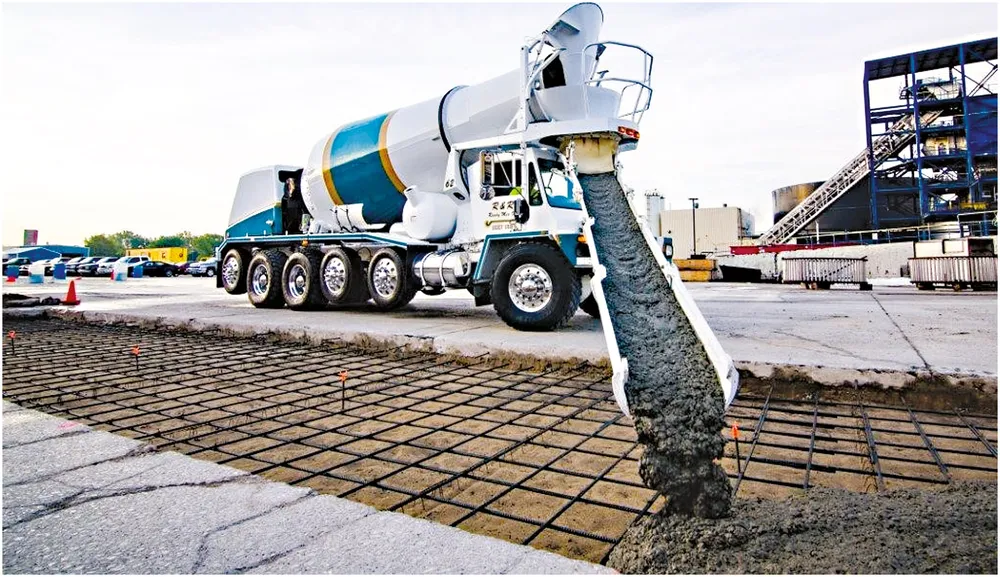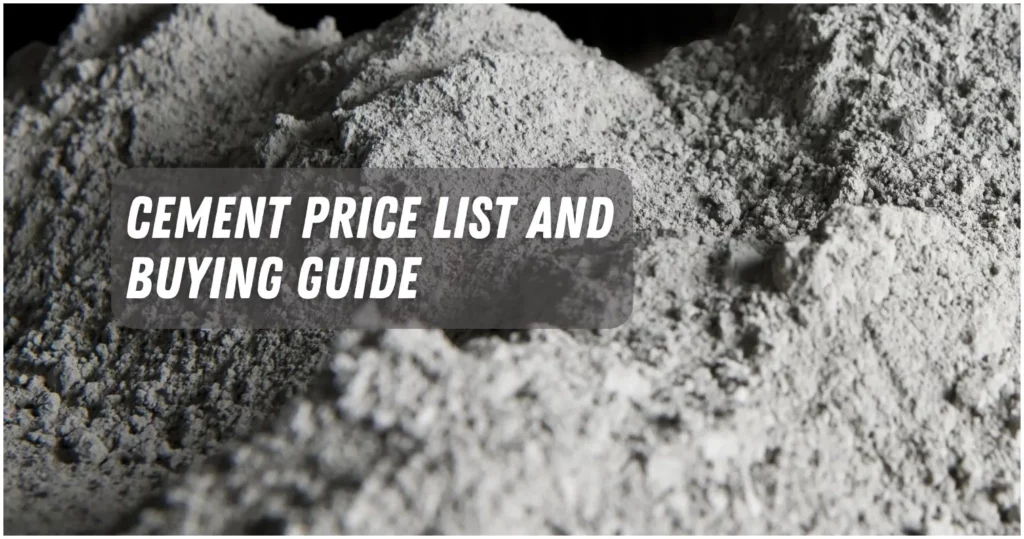Ready-mixed concrete is used in a lot of building projects in the Philippines. The Ready-mixed concrete price per cubic meter is generally between ₱4,900 and ₱6,950.
Here is all the information you need about the type, the pros and cons, how to choose, and the price list for ready-mix concrete in the Philippines.
What is Ready Mix Concrete?

Ready-mix concrete is a concrete mixture that is made in a factory or batching plant to fit the needs of a particular job. Then, transit mixers placed on trucks take it to the building site.
Expert suppliers prepare the concrete for this method, which makes it more durable, long-lasting, and of better quality. Ready-mixed concrete also lets you make special concrete mixes quickly and easily.
This method changed the way buildings were built. It was first used in the early 1900s, when it was supplied by horse-drawn mixers.
It is now a widely used product that makes building easier for big projects and places where mixing on-site is not possible.
Which Cement is Used For This?

Portland cement is most often used to make ready-mixed concrete. It is actually a mixture of Portland cement, water, and materials like sand, gravel, or crushed stone.
The chemical process called “hydration” is what gives concrete its strength and durability. This is when the paste, which is made of Portland cement and water, hardens and forms a solid mass.
The ratio of water to cement is a key factor in determining the quality of the concrete. In general, a lower ratio means better quality.
Whether OPC (Ordinary Portland Cement) or PPC (Portland Pozzolana Cement) is used relies on how long the concrete needs to cure and how good it needs to be for the building project.
The curing time for OPC is shorter, while the curing time for PPC is longer but the quality of the concrete is better.
It is important to work with an expert ready-mixed concrete supplier to make sure that the concrete mixture has the right design and proportions for maximum workability, strength, and durability.
Types of Ready Mixed Concrete
Based on how the concrete is mixed, there are three kinds of Ready Mix Concrete (RMC):
1. Transit Mixed Concrete

In this method, the concrete ingredients are put into the transit mixing truck at the factory or batching plant. While the materials are being put into the transit mixer, it turns quickly.
Once the mixer is full, it turns at a normal speed while in travel. There are different ways to do this method based on how the ingredients are mixed:
- Concrete is mixed at the building site. The mixer turns slowly while being moved, and then it turns as fast as it can for 70 to 100 times before the concrete is dumped out.
- Concrete is mixed at the yard, where the mixer turns at full speed for about 50 times before it is moved. During transport, it slowly turns and empties itself at the spot.
- Concrete mix in transit: While in transit, the mixer turns at a medium speed for about 70 turns, and then it stirs slowly until it gets to its location and dumps its contents.
2. Shrink Mixed Concrete

In this method, part of the mixing is done in the plant mixer, and the rest is done in the truck-mounted drum mixer while the concrete is being moved.
How well the transit mixer mixes depends on how well the central mixing plant mixes.
3. Central Mixed Concrete

This method, which is also known as “central batching plant,” includes mixing the concrete well before putting it in the truck mixer.
The plant mixer makes sure the mixture is mixed well, and the truck mixer works as an agitator while the plant mixer is moving.
When the distance is short or the workability needs are low, the concrete can also be moved with units that don’t move or dump trucks.
These three kinds of ready-mixed concrete have different benefits and are used based on the needs of the project and how it will be transported.
Ready Mix Concrete Price List
How much is the ready-mix concrete price Philippines? Check out the tables.
| Product | Curing Time | Price |
|---|---|---|
| Ready-Mix Concrete 3000 PSI | 28 days | ₱4,900 |
| 14 days | ₱5,200 | |
| 7 days | ₱5,450 | |
| 3 days | ₱6,000 | |
| Ready-Mix Concrete 3500 PSI | 28 days | ₱5,100 |
| 14 days | ₱5,400 | |
| 7 days | ₱5,750 | |
| 3 days | ₱6,150 | |
| Ready-Mix Concrete 4000 PSI | 28 days | ₱5,400 |
| 14 days | ₱5,750 | |
| Ready-Mix Concrete 4500 PSI | 28 days | ₱5,450 |
| 14 days | ₱6,150 | |
| Ready-Mix Concrete 5000 PSI | 28 days | ₱5,750 |
| 14 days | ₱6,450 | |
| Ready-Mix Concrete 6000 PSI | 28 days | ₱6,050 |
| 14 days | ₱6,950 |
Advantages and Disadvantages

There are some pros and cons from using ready-mix concrete, such as the following:
Ready-mixed concrete Pros
- Quality Assurance
Ready-mix concrete is made with exact amounts and high-tech tools, which makes it better.
During manufacturing, testing of materials, process parameters, and key practices are kept under tight control by using sophisticated tools and consistent methods.
- Labor Cost Reduction
When you use ready-mix concrete, you don’t have to store ingredients on-site and you need less labor to mix the concrete.
The concrete is brought to the job site already mixed, which saves time and effort.
- Environmental Benefits
Using ready-mix concrete instead of mixing it on-site reduces noise and air pollution at the building site. It also wastes less material, which makes the building process more environmentally friendly.
Using bulk concrete instead of cement bags saves cement and reduces waste in the environment.
- Time efficiency
RMC keeps building projects on schedule because concrete is always available and delivered on time. This helps get building work done on time.
Mixing is better and less cement is used because ready-mix concrete plants use high-tech tools to mix the concrete.
This cuts cement use by 10–12% compared to making it on-site. To get the grade of concrete you want, you can also use additives and other cement-like materials.
Ready-mixed concrete’s Cons:
- Initial Investment
Starting a ready-mix concrete plant needs a big initial investment, which may not be possible for small projects or individual contractors.
- Transportation Challenges
Transporting the concrete mixture from the plant to the job site without stopping requires good transportation methods. Delays in transport, like traffic jams, can change how easy the concrete is to work with and how quickly it sets.
- Time Limits
Ready-mix concrete can usually only be used for about 2 to 3 hours after it leaves the plant. Unexpected delays, like traffic or other problems, can make it hard to use the concrete in the best way.
- Considerations for the Formwork
Due to the bigger amounts of concrete delivered, the formwork and placement plans need to be set up ahead of time. This needs to be planned and coordinated well so that the concrete can be put down smoothly.
- Dependence on Outside Factors
Contractors don’t have much say over the quality of the concrete mix because it’s made by the ready-mix concrete provider. Getting the concrete mix from outside sources could make the building process less certain.
It’s important to remember that ready-mix concrete has a lot of benefits, but it also has some drawbacks and problems that need to be thought about and handled well during building projects.
How to Choose Ready Mix Concrete

To choose the right ready-mixed concrete, take these steps:
Learn the difference between concrete and cement
Concrete is a mix of cement, grit, and sand. Cement is the powdered material that holds the concrete together. To make good concrete, you must know how much of each of these products to use.
Consider the temperature and the area
If you expect the temperature to change or need to pour concrete in a small space, choose a mixture with air or a softener to make the concrete easier to pour and get to hard-to-reach areas.
Know what types of ready-mixed concrete are available
- Self-Leveling Concrete is great for flat, smooth areas because it levels itself without extra water or manual leveling.
- Rapid-setting concrete is good for commercial jobs because it sets up quickly, saving both time and energy.
- Fiber-reinforced concrete is strong even in very cold weather, making it great for driveways and parking spots.
- Standard ready-mix concrete is made in a controlled setting and is a popular choice for standard driveways because of its quality and ease of use.
- High-Strength Concrete: It is made to hold up to big industrial loads, so it is stronger.
Think about the site of the concrete batching plant
- Choose a place near power and water sources to make it easy to get to.
- Stay away from places with a lot of people because dust and noise pollution could be a problem.
- Check how easy it is to get there, how flat the land is, and if all the steps for industrial land are done.
Proximity to source of raw materials
- Choose a concrete batching plant that is close to the source of the raw materials to save time and money on shipping.
- In general, the business area for transporting raw materials is about 50 to 100 kilometers.
Choose the correct type and model of concrete plant
- Stationary type: Includes skip hopper and belt conveyor as choices. Ideal for small to medium-sized jobs or concrete manufacturers with a high demand.
- Mobile type: Good for short-term projects that require repeated moving. No base is needed before the installation.
Think about how the cement plant is put together
- The general performance is affected by things like the aggregate batching machine, the concrete mixer, the cement silo, the control system, and the belt conveyor.
- Choose trusted names, like Sicoma mixers, for better mixing.
- You can choose between fully automatic and semi-automatic control methods based on your needs.
Look at the linked supporting facilities
- Find out if you need extra equipment, like concrete mixer trucks, to get to the construction site.
- When you buy a full set from the same company, you can be sure that all of the parts will work well together and that the building will go faster.
Take your funds into consideration
Compare price from different ready mix concrete manufacturers, looking at both well-known brands and cheaper choices that are still of good quality.
Pay attention to after-sales services
- Check the manufacturer’s after-sale help, including installation, debugging, operator training, delivery of spare parts, maintenance, and regular visits.
- Choose a reputable and experienced manufacturer to get high-quality goods and great service.
By following these tips, you can make an informed choice and choose the right ready-mix concrete for your project.
FAQ Ready Mix Concrete
Is ready mix concrete stronger?
Yes, ready-mix concrete is stronger and more durable compared to other types of concrete.
Why is ready mix concrete important?
Ready mix concrete saves construction time and cost. It eliminates the need for on-site mixing, reduces labor requirements, and lowers storage costs.
What does ready mix concrete mean?
Ready mix concrete is concrete that is mixed at a central plant and then delivered to the construction site, instead of being mixed on-site.
Is ready mix concrete good or bad?
Ready mix concrete is good because it helps avoid common problems like poor workability, segregation, improper water-cement ratio, and inadequate mixing time that can occur with traditional concrete mixes.
How long does ready mix concrete last?
The shelf-life of ready mix concrete varies but is typically several months. If stored properly in controlled conditions, it may last up to a year.
Which cement is best for ready mix concrete?
Portland Cement is commonly used for ready mix concrete. It provides a strong bond and is suitable for driveways and pathways.
Is ready mix concrete cheaper?
Ready mix concrete is often have higher price than on-site mixing due to the convenience factor. It’s important to account for any spillages by ordering slightly more than needed, which can contribute to a higher cost.
What is the strength of ready mix concrete?
The compressive strength of ready mix concrete is typically 20 MPa/2900 psi. It is manufactured using computer-controlled operations and advanced equipment.
Is ready mix cement waterproof?
Ready mix cement can be made waterproof by using additives or specialized mixes. However, regular ready mix concrete is not inherently waterproof.
Does ready mix concrete need water?
Ready mix concrete is delivered to the site with the necessary water content already mixed in. There is no need to add water separately.
Does ready mix cement need sand?
Ready mixed mortar, which is a combination of sand and cement, is available for use without the need for additional sand. Water is added to achieve the desired consistency.
In the end, ready-mixed concrete has many perks for building projects. It is a strong and long-lasting choice that gets rid of many of the problems that come up with regular concrete mixes.
It also saves time and cuts down on the amount of work that needs to be done. But you should think about the price of ready mix concrete, which is often a little bit more expensive than making it on-site.
Even though ready-mixed concrete is expensive, its ease of use and high quality make it a good investment for efficient and reliable building projects.
[ratings]

